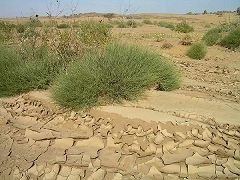| PlantID | 0095 |
| Botanical Name | Pulicaria crispa |
| Common Name | Dhola lizru |
| Classification | | Kingdom: | Plantae | | Subkingdom: | Tracheobionta | | Division: | Magnoliophyta | | Class: | Magnoliopsida | | Subclass: | Asteridae | | Order: | Asterales | | Family: | Compositae | | Genus: | Pulicaria | | Species: | crispa |
|
| Part used | Plant and bruised leaves. |
| Medicinal Properties | Antiseptic |
| Medicinal Use | Plant: used as antiseptic. Bruised leaves used to cure headache. |
| Chemistry | Beta-sitosterol, beta-amyrin, neutral triterpene and choline. Quercetin detected by TLC. Xanthanolides(I and II), pseudoguaianolide epoxide - pulicariolide - and secosesquiterpene lactone - secocrispiolide. |
| Cultivation | NA |
| Regional Habitat | Commonly found along dry river bed, fallow fields in sandy soil. Distribution: Ganganagar, Churu, Jhunjhunu, Nagaur, Jaiselmer, Barmer, Jodhpur, Bikaner, Pali, Udaipur, Dungarpur, Jaipur, Tonk, Bundi and Bharatpur districts of Rajasthan.
|
| Description | Diffuse or erect, 24-40 cm high herbs. Stem: ascending, striate. Leaves: auriculate or semi-amplexicaul at base, linear, oblong or oblanceolate, 0.8-4.0 x 0.15-0.7 cm, surfaces white-cottony pubescent, apex acute to sub-acute, margins coarsely toothed. Flowers: capitula 0.3-1.0 cm across, heterogamous, radiate; stalk 0.2-2.5 cm long; invol. bracts 2-3 seriate, linear, woolly-pubescent; those of outer series shorter; receptacle convex. Ray-florets: 1-2 seriate; pappus plumose, connate to outer ring of minute scales at base; corolla yellow; style 0.25 cm long, bifid. Disc-florets: 0.3 cm long; pappus as in ray-florets; corolla campanulate, yellow, lobes 5, minute, acute; anthers 0.15 cm long, tails capillary; style 0.2 cm long. Fruits: cypsels oblong, 0.05 cm long. Flowers and fruits appears during August-April.
|
| Image |  |


